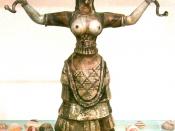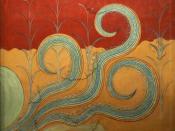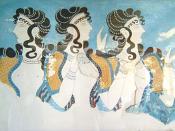Archaeological and architectural evidence, including frescoes, shrines, statues, pillars and column have contributed significantly to our understanding of Minoan religion. However, much of the evidence is missing or incomplete and thus, the knowledge of Minoan religion is limited. Nonetheless, historians have been able to develop an understanding of some aspects of Minoan religion through a variety of archaeological and architectural evidence such as the Aghia Triadha sarcophagus, cult furniture, seals, statues, skeletons, frescoes and pillars and columns.
Bronze Age societies held a common belief that supernatural forces controlled weather and fertility and that if gifts or offerings were presented, these forces would be generous to humans by minimising earthquakes and storms and maintaining the fertility of earth. Dickinson states that the Minoans held similar beliefs and that they were polytheistic. This is evidenced by the figurines and seals discovered bearing deities such as the snake goddess, the goddess of vegetaion and 'Mistress of the Animals'.
Gold signet rings bear a woman larger than the rest standing beneath a tree, probably the goddess central to Minoan religion, but she is believed to be Ashera, a Near Eastern goddess whose symbol is a tree. Male divinities were rare, and were often shown on a smaller scale than female figures. Nevertheless, there are difficulties in regards to how the Minoans saw the supernatural world and who the gods and goddesses were.
Votive offerings were presents given in honour of a god. Frequent offerings were models of animals and the labrys, either deliberately burnt, or broken. Some objects have been recovered holes and rocky fissures and historians conclude that this is how the earth gods and chthonic deities received offerings. Sistrums, religious pottery rattles were also used. At the palace at Zakro, a fountain was found containing votive offerings, which suggests that...


